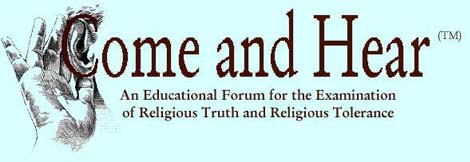Death Penalty and Talmud Law
4. US v. Talmud Law
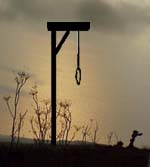
In 1999, the US Supreme Court accepted a death penalty brief based wholly on Talmud law. The advocates say the Talmud has a better way. Does it?
| Navigate This Site | |
 | |
| Home | |
| Valentine | |
| Dilling | |
| Talmud | |
| The Rabbis | |
| Supplement | |
| Glossary | |
| Download | |
| Admin | |
| | |
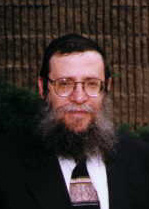
Rabbi Noson Gurary founded The National Institute for Judaic Law to educate American jurists and laws students about Judaic law. He is quoted in the Jerusalem Post:
"By demonstrating the philosophy of Jewish law and its moral values, we can bring a little beacon of light to this world." (1)
Rabbi Gurary is quoted by The Jewish Week: "Before you know where you're going, you have to know where you came from. And Jewish law is the basis of our legal system in America." (2)
In 1991, Congress declared the Talmud's Noahide Laws were the basis "upon which our great Nation was founded." Noahide Law regulations require that idolaters (such as Christians) be put to death. The 1991 declaration marked the 89th birthday of Rabbi Gurary's mentor, the Lubavitcher Rebbe, Rabbi Schneerson. See America's New Government Church.

Thomas Jefferson, author of the Declaration of Independence.
Writing to Charles Thomson, January 9, 1816, Jefferson refers to his anthology of the teachings of Jesus:
"A more beautiful or precious morsel of ethics I have never seen; it is a document in proof that I am a real Christian, that is to say, a disciple of the doctrines of Jesus … the great reformer of the vicious ethics and deism of the Jews." (14)
Jefferson wrote in the syllabus to the Jefferson Bible:
II. Jews.
1. Their system was Deism; that is, the belief in only one God. But their ideas of him and of his attributes were degrading and injurious.
2. Their Ethics were not only imperfect, but often irreconcilable with the sound dictates of reason and morality, as they respect intercourse with those around us; and repulsive and anti-social, as respecting other nations. They needed reformation, therefore, in an eminent degree.
III. Jesus.
In this state of things among the Jews, Jesus appeared. His parentage was obscure; his condition poor; his education null; his natural endowments great; his life correct and innocent: he was meek, benevolent, patient, firm, disinterested, and of the sublimest eloquence. (15)
A recent book, The Jefferson-Hemings Myth, debunks the story that Jefferson fathered children by his slave, Sally Hemings. The book addresses "How these attacks on Jefferson are also used to undermine the principles he stood for and on which the American republic was founded." (16)
For a biography of Jefferson by one of his contemporaries, see Life of Thomas Jefferson by B. L. Rayner. (17)
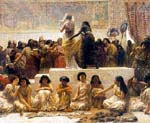
Babylonian Marriage Market by Edwin Long, 1875 (detail) (note ironic title)
Old Testament and Talmud law endorse and regulate slavery. For example, Mosaic Law endorses hereditary slavery:
Moreover of the children of the strangers that do sojourn among you, of them shall ye buy, and of their families that are with you, which they begat in your land: and they shall be your possession. And ye shall take them as an inheritance for your children after you, to inherit them for a possession; they shall be your bondmen for ever. — Leviticus 25:44-46
Using slaves for sex and having children by them is of course exemplified by Abraham's use of Hagar (Genesis 16:1-7 and Genesis 21:9-16.
Entries under the words slave, slaves, and slavery in the General Index of the Soncino Talmud fill almost two pages. See Appendix for some relevant Talmud passages, or use the Come and Hear™ Search Engine with words such as slave, bondwoman, bondman, manservant, maidservant, etc.

Justice Antonin Scalia. Along with Justices Ginsburg and Breyer, Justice Scalia attended the Kosher dinner held at the Supreme Court building on November 5, 2002, to mark the founding if the Washington-based National Institute for Judaic Law.
In 1993 a death penalty case (Herrera v. Collins) Scalia wrote that a condemned man awaiting execution did not have a right to another trial even if new evidence showed he was actually innocent of the crime. Scalia reasoned that because the condemned man's original trial had been free from procedural error, he'd have to die anyway, guilty or not.
"There is no basis in text, tradition, or even in contemporary practice (if that were enough) for finding in the Constitution a right to demand judicial consideration of newly discovered evidence of innocence brought forward after conviction."
 Leonel Torres Herrera (9)
Leonel Torres Herrera (9)
At the very moment Justice Scalia was writing those words, the Supreme Court was giving prisoner Herrera's case a "judicial consideration" that Justice Scalia said the man had no "right to demand." At that point, it was less expensive for the nation to save the man's life than to execute him. But Justice Scalia's decision was more a message to the nation than an exercise in justice: Justice Scalia is telling the nation and the world that in American justice, truth is unimportant in the face of procedure.
The Declaration of Independence — which sets forth the very purposes of our Nation — states, in part: "We hold these truths to be self-evident, that all men … are endowed by their Creator with certain unalienable Rights, that among these are Life …"
Article V of the Bill of Rights states: "No person shall be … deprived of life, liberty, or property, without due process of law …"
Judge Scalia is said to be a devout Catholic "with a fascination for Jewish law." Justice Scalia's curiosity about Jewish Law seems to coexist with his lack of interest in American justice.

You can help in the battle for Truth, Justice, and the American Way! Fight the forces of censorship and suppression of the Talmud, and bring about understanding between peoples of different faiths.
Download this site to your desktop computer.
Make CDs and distribute them to friends, neighbors, ministers, and community leaders.
Email your favorite essay to your email list.
Post your favorite essay to discussion forums.
Print your favorite essays and give them to those not on the Internet.
Flyers advertising Come-and-Hear.com can be distributed throughout your community.
 Genuine Come and Hear™ CDs do not contain executable programs. When making CDs, do not include any files that end in .exe, .com, .bat, .vbs, .doc, .pif, .sit, or .scr. The person receiving the CD should use his own browser to view the files. This helps to protect him from harmful programs and viruses.
Genuine Come and Hear™ CDs do not contain executable programs. When making CDs, do not include any files that end in .exe, .com, .bat, .vbs, .doc, .pif, .sit, or .scr. The person receiving the CD should use his own browser to view the files. This helps to protect him from harmful programs and viruses.

"US President George W. Bush sent greetings and applauded the institute for promoting an 'understanding of Judaism's rich tradition of legal thought. As we face new challenges and welcome new opportunities, our society must continue to promote good character and strong values. Through the study and teaching of Jewish law and philosophy you are contributing to a growing culture of service, citizenship, and responsibility in America,' Bush wrote."
The occasion was a kosher dinner held at the US Supreme Court Building in Washington, DC by the National Institute for Judaic Law to celebrate the occasion of the Institute's founding. (1)
This is the fourth in a 4-part series on the Death Penalty and Talmud Law.
In Sentence and Execution (Part 1 of "Death Penalty and Talmud Law") we watched the US Supreme Court create a precedent by accepting for consideration a brief based wholly on Talmud law. We watched as Israeli and American legal experts recommended that, on the issue of humanitarianism and the death penalty, that the US should use Talmud law as the exemplar.
What was missing from this presentation? The Orthodox Jewish advocates failed to mention that US and Talmud law are fundamentally incompatible.
Over the cornice of the Supreme Court building are etched these words:

In contrast, Talmud law insists on unequal justice under law. Talmudic law holds there is one law for Jews, and one for Gentiles. This is not inconsistent with the Old Testament, in which LORD God decrees that Jews should not enslave other Jews: Gentiles are the proper slaves of Jews.
- Both thy bondmen, and thy bondmaids, which thou shalt have, shall be of the heathen that are round about you; of them shall ye buy bondmen and bondmaids.
- Moreover of the children of the strangers that do sojourn among you, of them shall ye buy, and of their families that are with you, which they begat in your land: and they shall be your possession.
- And ye shall take them as an inheritance for your children after you, to inherit them for a possession; they shall be your bondmen for ever: but over your brethren the children of Israel, ye shall not rule one over another with rigour.
Laws concerning slaves — bondmen, bondmaid, bondwomen, handmaids, etc. — are found throughout the Talmud in almost every tractate. A sampling of such laws is included in the Appendix: Talmud Slavery Laws.
Gentiles Easy To Convict
Under Jewish law, Gentiles are easy to convict for capital crimes; but it is difficult to convict Jews. The standards of proof are different.
For a Jew to be convicted by a Jewish court, two eyewitnesses must have seen the perpetrator about to commit the crime and warned him of the potential penalty. The murderer must verbally answer that he chooses to proceed anyway. (For a non-Jew, only one witness is required and no verbal warning.)
— Rabbi Adlerstein, as told to Naomi Pfefferman (5)
Rabbi Adlerstein's statement is confirmed by the Talmud.
(When excerpting the Talmud, we sometimes omit footnotes and non-germane text. The omission of text is indicated by an ellipsis (…). The full text and footnotes may be found by following the hot link at the end of the excerpt. It is our pleasure to make available the text of the complete tractates cited in this article, so you may read the Talmud in full context.)
GEMARA. … R. Jacob b. Aha found it written in the scholars' Book of Aggada: A heathen is executed on the ruling of one judge, on the testimony of one witness, without a formal warning, on the evidence of a man, but not of a woman, even if he [the witness] be a relation.
— Babylonian Talmud, Tractate Sanhedrin 57b
Soncino 1961 Edition, page 390
Rabbi Adlerstein's statement is also confirmed by Talmud scholar and translator, Rabbi Dr. H. Freedman. In the following quotes, "Noahide" means a non-Jew. Rabbi Dr. Freedman tells us twenty-three judges must sit on a court that hears a capital case against a Jew; when a Gentile is tried on a capital charge, one (Jewish) judge is required.
- A Noachide is tried by one judge, and on the testimony of one witness only, and is executed even if no formal admonition preceded his offence; a Jew is tried by a court of twenty-three, on the testimony of at least two, and only after formal admonition. Moreover, a gentile is decapitated, whereas a Jew is stoned.
— Rabbi Dr. Freedman (6)
Laws Different for Jew and Gentile
Not only are the court procedures and the standards of evidence different from one class to the other, the very laws are different. For example, if a Jew murders a Gentile, there is no death penalty.
GEMARA. … 'For murder, whether of a Cuthean by a Cuthean, or of an Israelite by a Cuthean, punishment is incurred; but of a Cuthean by an Israelite, there is no death penalty'
— Babylonian Talmud, Tractate Sanhedrin 57a
Soncino 1961 Edition, page 388
But if a Gentile strikes a Jew, "he is worthy of death."
GEMARA. … R. Hanina said: If a heathen smites a Jew, he is worthy of death, for it is written, And he looked this way and that way, and when he saw that there was no man, he slew the Egyptian. R. Hanina also said: He who smites an Israelite on the jaw, is as though he had thus assaulted the Divine Presence; for it is written, one who smiteth man [i.e. an Israelite] attacketh the Holy One.
— Babylonian Talmud, Tractate Sanhedrin 58b
Soncino 1961 Edition, page 398
No Jury of Peers under Talmud Law
Talmud law does not provide for the accused to be tried by a jury of his peers. In Talmud law, the accused is tried by rabbis.
Ox Gets 23 Judges
In case there were any doubt about the place of the Gentile in Talmud law, the following excerpt from Sanhedrin 2a settles the question. Recall that a capital case against a Gentile is heard by one judge. According to Sanhedrin 2a, a capital case against an ox, a hyena, or a serpent is tried by 23 judges.
MISHNAH. … CAPITAL CASES ARE ADJUDICATED BY TWENTY-THREE. THE PERSON OR BEAST CHARGED WITH UNNATURAL INTERCOURSE, BY TWENTY-THREE, AS IT IS WRITTEN, THOU SHALT KILL THE WOMAN AND THE BEAST, AND ALSO, AND YE SHALL SLAY THE BEAST.
THE OX TO BE STONED IS TRIED BY TWENTY-THREE, AS IT IS WRITTEN, THE OX SHALL BE STONED AND ITS OWNER SHALL BE PUT TO DEATH — AS THE DEATH OF THE OWNER, SO THAT OF THE OX, CAN BE DECIDED ONLY BY TWENTY-THREE.
THE DEATH SENTENCE ON THE WOLF OR THE LION OR THE BEAR OR THE LEOPARD OR THE HYENA OR THE SERPENT IS TO BE PASSED BY TWENTY-THREE. R. ELIEZER SAYS: WHOEVER IS FIRST TO KILL THEM [WITHOUT TRIAL], ACQUIRES MERIT, R. AKIBA, HOWEVER, HOLDS THAT THEIR DEATH IS TO BE DECIDED BY TWENTY-THREE.
— Babylonian Talmud, Tractate Sanhedrin 2a
Soncino 1961 Edition, page 2
Perspective on Gentiles
A further perspective in traditional Jewish laws and attitudes concerning Gentiles is contained in What About Gentiles? (18) Of particular interest is the modern study by Rabbi David Bar-Chayim, the head of the Makhon Ben Yishai Institute for Torah Research. Israel National Radio calls Rabbi Bar-Chayim "one of Israel's Leading Torah Scholars." (19) Rabbi Bar-Chayim's essay, The Jews Are Called "Man," offers a definitive statement of the doctrines concerning Gentiles, with extensive references to many Jewish Scriptures. (20)
US Supreme Court Warms to the Talmud
Approximately three years after Nathan and Alyza Lewin filed the Bryan v. Moore amicus curiae brief — a notable event in itself — another notable event took place. A kosher dinner was held to honor the establishment of the National Institute for Judaic Law (NIJL). The dinner was attended by 200 people, including Supreme Court Justices Ruth Bader Ginsberg, Stephen Breyer, Antonin Scalia. Nathan and Alyza Lewin also attended.
The site of the dinner? The United States Supreme Court Building in Washington, DC. The Jewish Week reported the event in this manner:
What does the Talmud have to say about legal and moral controversies in modern America?
Plenty, according to the creators of the new Washington-based National Institute for Judaic Law, which opened with a lavish Supreme Court dinner last month.
Some Orthodox activists say they can't figure out exactly the point of the whole thing. But Noson Gurary, a Lubavitch rabbi who came up with the idea and won backing from some top Jewish legal experts, harbors no doubts.
— Jewish Week (2)
Noson Gurary is an ordained rabbi of the Chabad Lubavitch sect, and follower of late Rabbi Menachem Mendel Schneerson. Chabad Lubavitch is a movement within the Hasidic (sometimes spelled "Chasidic") branch of Judaism. Rabbi Gurary is the executive director of Chabad of Buffalo, New York. (3) He is co-author of several books on Hasidic and Chabad Lubavitch philosophy. (7) Hasidism embraces a Kabbalistic concept of God, the Ein-Sof, (8), a power reminiscent of "The Force" in George Lucas' Star Wars.
Coming from Where We've Never Been
The Jewish Week explains more of the NIJL project. In the following paragraph, macher is a Yiddish word meaning "big shot," a person with access to authorities. (10)
According to Gurary, the group, which has hired two researchers to compile reports, will focus initially on the issue of business ethics. Eventually, the goal is to compile a library and database in Washington that will offer Jewish law insights into a host of contemporary issues and to help create courses on the subject at law schools nationwide. The institute will also inaugurate a monthly lunch series for legal machers in Washington.
— Jewish Week (2)
The Jewish Week continues:
"It will be an eye opener for judges, scholars and law students," he told The Jewish Week. "Before you know where you're going, you have to know where you came from. And Jewish law is the basis of our legal system in America." …
Gurary, who teaches at the University of Buffalo law school, said his target audience includes judges around the country and law students, not politicians and lawmakers.
"And as a teacher of Judaic studies, I began to see the excitement of students who were being exposed to Jewish law for the first time, who now had a better understanding of where Western law come from," Gurary said.
— Jewish Week (2)
It is a safe bet that all of Rabbi Gurary's students had been exposed to the Ten Commandments before, and none were encountering them "for the first time" in his classroom. Hence, Rabbi Gurary's term "Jewish law" must refer to Talmud law rather than Biblical law. Thus, Rabbi Gurary's statement reads that Western law "came from" Talmud law — and that is patently false. The sources for law in Europe and America include Roman law, Anglo-Saxon law, and the Western philosophers of Liberty. Neither American nor European law has ever institutionalized legal superiority of Jew over Gentile.
Bush Approves Talmudization of America
The Jerusalem Post reported the November 2002 kosher dinner as follows:
Jewish legal experts have created a new institute that will educate jurists and others about 2,000 years of Jewish law and promote the application of the teachings to contemporary legal disputes and other modern- day issues …
US President George W. Bush sent greetings and applauded the institute for promoting an "understanding of Judaism's rich tradition of legal thought."
"As we face new challenges and welcome new opportunities, our society must continue to promote good character and strong values. Through the study and teaching of Jewish law and philosophy you are contributing to a growing culture of service, citizenship, and responsibility in America," Bush wrote.
— The Jerusalem Post (1)
Justice Scalia Is a Key Player
The Jerusalem Post reports that Justice Antonin Scalia has high praise Jewish law.
Scalia, in a letter to the institute's founder, Noson Gurary, wrote that "Jewish law is certainly one of the oldest and most highly developed systems" and explained why the comparative study of legal traditions was beneficial.
— The Jerusalem Post (1)
In fact, Rabbi Gurary came up with the idea of the Institute as a result of correspondence with Justice Scalia:
Gurary said that the idea for the institute came in an exchange of letters in which Supreme Court Justice Antonin Scalia, one of the most conservative Justices, expressed his "fascination with Jewish law."
— The Jerusalem Post (1)
Justice Scalia has sworn an oath to uphold the Constitution and its Bill of Rights. Yet, by his attendance at this dinner he clearly indicated his support for an antithetical system: Talmud law. How does he reconcile the two? We are not told.
Talmud vs. Old Testament
Some non-Jews take the position that the Talmud perverted the Old Testament teachings. See, for example, Chapter I of Elizabeth Dilling's The Jewish Religion: It's Influence Today. The question then becomes: If the Talmud perverted Jewish law, what is real, un-perverted Jewish law — the Jewish law of the Old Testament? What was the quality of justice that pervaded the mind-set of the ancient Jews? Should we in America emulate that Old Testament sense of justice?
We have prepared a sampling of Old Testament passages in a compendium called In His Own Image. (21) Let us examine an incident described in Genesis 34.
Shechem is a Gentile, a Hivite. Jacob's daughter, Dinah, catches his eye. Under circumstances not fully described, Shechem seduces Dinah. Shechem loves Dinah tenderly and wants her as his wife. He offers to give any dowry asked for her, and suggests to Jacob's family that their two tribes be joined. While harboring vengeance in their hearts, Jacob's sons (the progenitors of the Tribes of Israel) deceitfully agree to the merger, but insist that the Hivite men be circumcised. The Hivites agree. While the Hivite men are recovering from the operation and still in pain, the Hebrews attack the city, kill all the men, and take the women and children as captives — slaves.
- And Dinah the daughter of Leah, which she bare unto Jacob, went out to see the daughters of the land.
- And when Shechem the son of Hamor the Hivite, prince of the country, saw her, he took her, and lay with her, and defiled her.
- And his soul clave unto Dinah the daughter of Jacob, and he loved the damsel, and spake kindly unto the damsel.
- And Shechem spake unto his father Hamor, saying, Get me this damsel to wife.
- And Jacob heard that he had defiled Dinah his daughter: now his sons were with his cattle in the field: and Jacob held his peace until they were come.
- And Hamor the father of Shechem went out unto Jacob to commune with him.
- And the sons of Jacob came out of the field when they heard it: and the men were grieved, and they were very wroth, because he had wrought folly in Israel in lying with Jacob's daughter: which thing ought not to be done.
- And Hamor communed with them, saying, The soul of my son Shechem longeth for your daughter: I pray you give her him to wife.
- And make ye marriages with us, and give your daughters unto us, and take our daughters unto you.
- And ye shall dwell with us: and the land shall be before you; dwell and trade ye therein, and get you possessions therein.
- And Shechem said unto her father and unto her brethren, Let me find grace in your eyes, and what ye shall say unto me I will give.
- And Shechem said unto her father and unto her brethren, Let me find grace in your eyes, and what ye shall say unto me I will give.
- Ask me never so much dowry and gift, and I will give according as ye shall say unto me: but give me the damsel to wife.
- And the sons of Jacob answered Shechem and Hamor his father deceitfully, and said, because he had defiled Dinah their sister:
- And they said unto them, We cannot do this thing, to give our sister to one that is uncircumcised; for that were a reproach unto us:
- But in this will we consent unto you: If ye will be as we be, that every male of you be circumcised;
- Then will we give our daughters unto you, and we will take your daughters to us, and we will dwell with you, and we will become one people.
- But if ye will not hearken unto us, to be circumcised; then will we take our daughter, and we will be gone.
…- And unto Hamor and unto Shechem his son hearkened all that went out of the gate of his city; and every male was circumcised, all that went out of the gate of his city.
- And it came to pass on the third day, when they were sore, that two of the sons of Jacob, Simeon and Levi, Dinah's brethren, took each man his sword, and came upon the city boldly, and slew all the males.
- And they slew Hamor and Shechem his son with the edge of the sword, and took Dinah out of Shechem's house, and went out.
- The sons of Jacob came upon the slain, and spoiled the city, because they had defiled their sister.
- They took their sheep, and their oxen, and their asses, and that which was in the city, and that which was in the field,
- And all their wealth, and all their little ones, and their wives took they captive, and spoiled even all that was in the house.
- And Jacob said to Simeon and Levi, Ye have troubled me to make me to stink among the inhabitants of the land, among the Canaanites and the Perizzites: and I being few in number, they shall gather themselves together against me, and slay me; and I shall be destroyed, I and my house.
- And they said, Should he deal with our sister as with an harlot?
While many religions frown on sex before marriage, most of us understand that unmarried sex happens. If a man — or even the son of the prince — slept with our sister before marriage, few of us would think it appropriate to murder all the other men in the city, loot the fields and buildings, and take the women and children into slavery. Nor is it likely, having done such a thing, that we would find a sympathetic judge or jury to hear our case. In short, what we have here is a very different concept of justice — so different that many of us could not agree it should be called "justice." The Bible passage shows that:
- Shechem, a Gentile, is not accused of using force or violence on Dinah
- Shechem declared his love for Dinah, and pleaded for her as his bride
- Shechem asked Jacob to name any dowry he would like
- Shechem expressed his good will toward Jacob's tribe, offering a merger of wealth and fortunes
- Jacob's sons responded deceitfully, pretending friendship and planning murder
- Jacob's sons slew other men who were not implicated in the seduction
- The women and children taken in slavery were blameless victims — of Jacob's sons
- Between the time that Shechem came to Jacob and the time that Dinah was taken from Shechem's house, there were approximately three days. During that time, Jacob and his sons knowingly permitted Dinah to be "defiled" without protest. In consideration of the treasure and slaves looted from the city, did not Jacob and his sons "deal with [their] sister as with an harlot?"
Jacob's final statement on the issue is particularly telling: He complained to his sons that they had put him at odds with the local tribes, and they might retaliate. In no other way did Jacob find fault with their actions.
We have examined each of the Soncino Scriptural index entries for Genesis Chapter 34: there are no comments from the Sages on the injustice in this incident. All apparently approve of the actions of their ancestors.
This is the Old Testament tradition, repeated over and over again through many narratives, as cited in In His Own Image. In particular, note the fate of those who do not follow the Hebrew religion — they are put to death. Is this the tradition of law and justice for which we should trade our Bill of Rights?
A Little Beacon of Light
Many defend the Old Testament because, they say, it contains commandments that regulate human interaction and produce an ordered society. But earlier civilizations had codes of law regulating human society. See, for example, the Code of Hammurabi, who reigned in Babylon between 1795 and 1750 BC. (12) Moses received the Tablets of Stone in 1275 BC. (13) Hammurabi's Code was on public display approximately 500 years before LORD God's conversation with Moses on Mt. Sinai.
In its report of the November, 2002 kosher dinner at the Supreme Court, The Jerusalem Post quotes Rabbi Gurary thus:
By demonstrating the philosophy of Jewish law and its moral values, we can bring a little beacon of light to this world.
— Rabbi Gurary, quoted in The Jerusalem Post (1)
How much light Jewish law and its moral values brought to this world is a subject for open, informed discussion. See also Was Jesus a Jew?
Thank you for your consideration of the above,
Carol A. Valentine, [email protected]
July 14, 2003 ( This article is on line at http://www.come-and-hear.com/editor/capunish_4.html )
|
Navigate Carol Valentine's America Under the Talmud — Will It Work for US? | |||||
 Howdy! |
 The Roadmap |
 Censorship |
 Death Penalty |
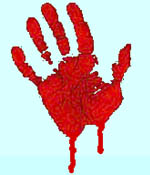 Blood Ritual |
 New America |
| Navigate This Site | |
 | |
| Home | |
| Valentine | |
| Dilling | |
| Talmud | |
| The Rabbis | |
| Supplement | |
| Glossary | |
| Download | |
| Admin | |
Endnotes:
- This and other Come and Hear™ Studies on Talmudic Judaism can be found online:
- http://www.come-and-hear.com/editor
- The Jewish Religion: Its Influence Today by Elizabeth Dilling, complete with all 300 exhibits, can be found online:
- http://www.come-and-hear.com/dilling
- Soncino Babylonian Talmud tractates, with Forewords, Introductions, Glossary, List of Abbreviations, and footnotes. Now you can study the Babylonian Talmud in full context and with the running commentary of the finest scholars of Judaism:
- Tractate Berakoth: http://www.come-and-hear.com/berakoth
- Tractate Shabbath: http://www.come-and-hear.com/shabbath
- Tractate Yebamoth: http://www.come-and-hear.com/yebamoth
- Tractate Kethuboth: http://www.come-and-hear.com/kethuboth
- Tractate Nedarim: http://www.come-and-hear.com/nedarim
- Tractate Nazir: http://www.come-and-hear.com/nazir
- Tractate Sotah: http://www.come-and-hear.com/sotah
- Tractate Gittin: http://www.come-and-hear.com/gittin
- Tractate Baba Kamma: http://www.come-and-hear.com/babakamma
- Tractate Baba Mezi'a: http://www.come-and-hear.com/babamezia
- Tractate Baba Bathra: http://www.come-and-hear.com/bababathra
- Tractate Sanhedrin: http://www.come-and-hear.com/sanhedrin
- Tractate Abodah Zarah: http://www.come-and-hear.com/zarah
- Tractate Horayoth: http://www.come-and-hear.com/horayoth
- Tractate Niddah: http://www.come-and-hear.com/niddah
- Tractate Tohoroth: http://www.come-and-hear.com/tohoroth
- Search the Talmud http://www.come-and-hear.com/tindex.html
- Download all the above resources for local study, CD, or mirror web site:
- http://www.come-and-hear.com/download
Appendix: Talmud Slavery Laws
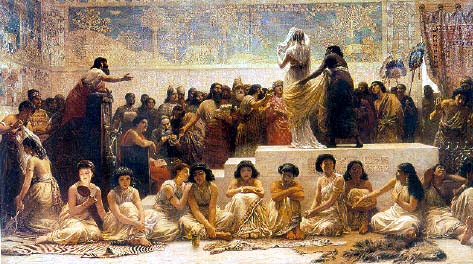 |
|
Babylonian Marriage Market by Edwin Long, 1875 Of course, people who are bought and sold are normally called "slaves," and the artist's title is ironic. |
Sampling of Slavery Laws and Regulations in the Talmud
The basis for Jewish slavery, and particularly the enslavement of Gentiles, is found in the Old Testament in Leviticus 25:44-46.
- Both thy bondmen, and thy bondmaids, which thou shalt have, shall be of the heathen that are round about you; of them shall ye buy bondmen and bondmaids.
- Moreover of the children of the strangers that do sojourn among you, of them shall ye buy, and of their families that are with you, which they begat in your land: and they shall be your possession.
- And ye shall take them as an inheritance for your children after you, to inherit them for a possession; they shall be your bondmen for ever: but over your brethren the children of Israel, ye shall not rule one over another with rigour.
The Talmud contains detailed regulations concerning slaves and slavery. Use Search Come and Hear™ to search for "slave" in the Talmud tractates on line. Of those approximately 1,500 files, 301 contain slavery regulations. We have selected five for inclusion here, adding emphasis to aid the reader. An ellipsis (…) indicates text omitted by the Come and Hear™ editor. The full text is available through the cite hot link.
MISHNAH. A PRESUMPTIVE TITLE TO HOUSES, PITS, DITCHES AND CAVES, DOVECOTES, BATHS, OLIVE PRESSES, IRRIGATED FIELDS, SLAVES, AND ANYTHING WHICH IS CONTINUALLY PRODUCING IS CONFERRED BY THREE YEARS [UNCHALLENGED POSSESSION] FROM DAY TO DAY.
— Babylonian Talmud, Tractate Baba Bathra 28a
Soncino 1961 Edition, page 138
MISHNAH. IF A MAN SELLS A TOWN, HE [AUTOMATICALLY INCLUDES THE HOUSES,7 THE PITS, DITCHES AND CAVES, THE BATHS, THE PIGEON COTES, AND THE IRRIGATED FIELDS [ATTACHED TO IT], BUT NOT MOVABLES. IF, HOWEVER, HE USED THE WORDS 'IT AND ALL ITS CONTENTS', EVEN IF THERE WERE CATTLE AND SLAVES IN IT THEY ARE ALL SOLD.
— Babylonian Talmud, Tractate Baba Bathra 68a
Soncino 1961 Edition, page 270
MISHNAH. IF A MAN SETS FIRE TO A STACK OF CORN IN WHICH THERE HAPPEN TO BE ARTICLES AND THESE ARE BURNT, R. JUDAH SAYS THAT PAYMENT SHOULD BE MADE FOR ALL THAT WAS THEREIN, WHEREAS THE SAGES SAY THAT NO PAYMENT SHOULD BE MADE EXCEPT FOR A STACK OF WHEAT OR FOR A STACK OF BARLEY. [WHERE FIRE WAS SET TO A BARN TO WHICH] A GOAT HAD BEEN FASTENED AND NEAR WHICH WAS A SLAVE [LOOSE] AND ALL WERE BURNT WITH THE BARN, THERE WOULD BE LIABILITY.12 IF, HOWEVER, THE SLAVE HAD BEEN CHAINED TO IT, AND THE GOAT WAS LOOSE NEAR BY IT, AND ALL WERE BURNT WITH IT, THERE WOULD BE EXEMPTION.
— Babylonian Talmud, Tractate Baba Kamma 61a
Soncino 1961 Edition, pages 356-357
MISHNAH. ONE WHO INJURES A FELLOW MAN BECOMES LIABLE TO HIM FOR FIVE ITEMS: FOR DEPRECIATION, FOR PAIN, FOR HEALING, FOR LOSS OF TIME AND FOR DEGRADATION. HOW IS IT WITH 'DEPRECIATION'? IF HE PUT OUT HIS EYE, CUT OFF HIS ARM OR BROKE HIS LEG, THE INJURED PERSON IS CONSIDERED AS IF HE WERE A SLAVE BEING SOLD IN THE MARKET PLACE, AND A VALUATION IS MADE AS TO HOW MUCH HE WAS WORTH [PREVIOUSLY]. AND HOW MUCH HE IS WORTH [NOW].
— Babylonian Talmud, Tractate Baba Kamma 83b
Soncino 1961 Edition, page 473
MISHNAH. [RABBAN GAMALIEL] BATHED ON THE FIRST NIGHT AFTER THE DEATH OF HIS WIFE. HIS DISCIPLES SAID TO HIM: YOU HAVE TAUGHT US, SIR, THAT A MOURNER IS FORBIDDEN TO BATHE. HE REPLIED TO THEM: I AM NOT LIKE OTHER MEN, BEING VERY DELICATE. WHEN TABI HIS SLAVE DIED HE ACCEPTED CONDOLENCES FOR HIM. HIS DISCIPLES SAID TO HIM: YOU HAVE TAUGHT US, SIR, THAT CONDOLENCES ARE NOT ACCEPTED FOR SLAVES? HE REPLIED TO THEM: MY SLAVE TABI WAS NOT LIKE OTHER SLAVES: HE WAS A GOOD MAN …
GEMARA … WHEN TABI HIS SLAVE DIED etc. Our Rabbis taught: For male and female slaves no row [of comforters] is formed, nor is the blessing of mourners said, nor is condolence offered. When the bondwoman of R. Eliezer died, his disciples went in to condole with him. When he saw them he went up to an upper chamber, but they went up after him. He then went into an ante-room and they followed him there. He then went into the dining hall and they followed him there. He said to them: I thought that you would be scalded with warm water; I see you are not scalded even with boiling hot water. Have I not taught you that a row of comforters is not made for male and female slaves, and that a blessing of mourners is not said for them, nor is condolence offered for them? What then do they say for them? The same as they say to a man for his ox and his ass: 'May the Almighty replenish your loss'. So for his male and female slave they say to him: 'May the Almighty replenish your loss'. It has been taught elsewhere: For male and female slaves no funeral oration is said. R. Jose said: If he was a good slave, they can say over him, Alas for a good and faithful man, who worked for his living! They said to him: If you do that, what do you leave for free-born?
— Babylonian Talmud, Tractate Berakoth 16b (emphasis added)
Soncino 1961 Edition, pages 96-97
While the United States of America renounced and outlawed slavery with the passage of the Fourteenth Amendment, there is no mechanism in Judaism that could vacate or cancel the Old Testament or Talmud slavery laws. And they have not been canceled. Those laws are the Word of God.
